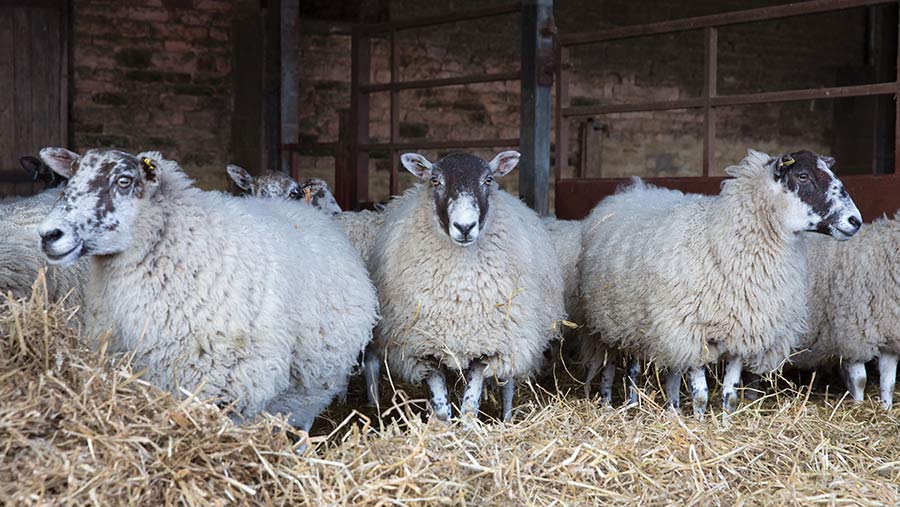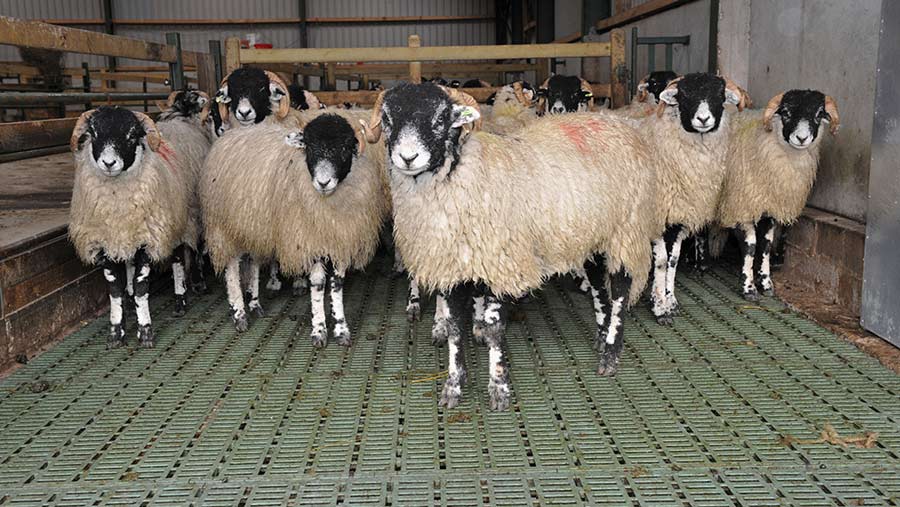Alternative bedding for sheep: What to consider
Materials used to bed sheep at lambing must deliver on comfort but other considerations are needed, not least protecting the ewe and her lambs from potentially harmful organisms.
Straw is still the most commonly used bedding material in UK lambing systems and for good reason, says independent sheep specialist Liz Genever.
She describes straw as the “gold standard” of bedding materials, but amid rising straw costs and availability issues in non-arable regions, flock owners have been putting alternatives to the test.
Due to lower water intakes, sheep use much less bedding than cows – especially when they are on dry diets – but the absorption ability of the bedding must be considered.
“There has been very little research work on alternative sheep bedding materials, but there are some good products that will do the job if straw isn’t an option,’’ says Dr Genever.
To keep animals clean and dry, bedding choice is important, so what are the options?
See also: How to design the best sheep handling system
Straw

© Tim Scrivener
Cost (excluding transport)
£55-£61/t based on August prices; pens require around 2kg for each lambing.
“The price is not going to go down this year; it might well go up because there is less straw about because of the challenging growing conditions,’’ says Dr Genever.
To reduce costs, use a cheaper oat straw as a base and cover with a layer of higher-quality wheat straw. Dr Genever recommends wheat straw rather than barley straw, which can be itchy and sheep are more likely to eat it.
Straw should be clean and dry when it arrives on the yard.
“The quality of the straw that has been harvested this year is not as good as some years, so don’t be afraid to ask the supplier about the quality. If it falls short when it arrives, challenge the agreed price.’’
Pros
- Comfortable and retains heat
Cons
- High haulage costs – as high as £30/t depending on distance and time of year
- Price and quality is variable year on year
- Dusty straw can cause respiratory problems
- A high carbon footprint – transporting a tonne 180 miles on an articulated lorry produces 42kg of carbon dioxide
Absorbency
At 2-2.5 litres/kg the absorbency is average. Condensation or leaky water troughs will increase moisture in straw, harbouring disease.
Nesting score (0-5): 5
But only if there is sufficient depth for sheep to scratch up.
“There is nothing happier than a sheep in a good layer of clean fresh straw, but this comes at a cost,’’ says Dr Genever.
Bacterial count
All wet bedding materials will harbour bacteria and transmit these between animals; straw is no different.
If it is clean and dry the bacterial count is relatively low, but the time gap between clean and dirty bedding is just 12 hours. Monitor cleanliness and top up or remove as needed to reduce that risk.
The more animals that pass through a pen, the higher the risk of infection.
Disposal considerations
Straw breaks down easily and has a high fertiliser value, so it is good for improving land. Although sheep manure doesn’t have the same fertiliser value as cattle manure it is beneficial as an organic matter.
Sawdust
Cost (excluding transport)
Expect to pay £7/17kg bale. Most sheep farmers don’t use enough to buy bulk loads or large deliveries of bags, unless they are also buying for cubicle-bedded cows.
Prices have increased sharply due to competition from biomass burning, and as a result of a shortage created by the lockdown.
It is worth paying more to get the best sawdust available, rather than trying to save a few pounds and getting something that can be highly damaging to health and performance.
Pros
- Can be used under straw bedding to extend the working life of straw
- Rots down well
- Easy to use because it is light
- Non-abrasive
- Doesn’t cause clouds of dust if the quality is good, but some poorer quality material can be very dusty
- Some manufacturers market dust-free options
Cons
- Availability may be problematic this winter, although there were shortages prior to the pandemic lockdown due to biomass boilers being installed into timber mills and elsewhere
- Can be a highly variable material
- Poor quality sawdust can be damp
- Unscreened materials can contain shards of wood and even nails. Farmers must check that they are using a product that contains no glue, resin or foreign materials, as these are not permitted for use as bedding on-farm.
- Very fine sawdust sticks to fleece and can cake onto teats
Absorbency
Sawdust with a low dry matter (DM) content offers a fair-to-good level of absorbency at 1.5 to 2.5 litres/kg. But it does become wet very quickly, increasing the risk of bacteria build up.
Softwood varieties are more absorbent than hardwood.
Nesting score (0-5): 4
It doesn’t quite measure up to straw, but comes a close second. In one study, animals also showed a preference for lying down on sawdust rather than straw.
Bacterial count
Damp sawdust supports many pathogens and harbours moulds, so it must be kept dry – both in use and storage. Adequate ventilation can play a major role in removing moisture and heat from the shed, reducing humidity and allowing beds to dry.
It can be beneficial to use an anti-bacterial bedding powder in conjunction with sawdust to control bacteria.
Disposal considerations
Depending on particle size, it may require composting before spreading. It is easy to spread but can lock-up nitrogen.
Paper
Cost (excluding transport)
A 15kg bag of shredded paper costs about £3.
Pros
- Has good thermal properties
- Highly absorbent
Cons
- Needs to be mucked out regularly
- Difficult to handle when it gets wet
- Can lock up nitrogen when spread onto fields
Absorbency
Shredded paper is very absorbent, particularly if kiln-dried when its moisture content is only 10%.
Nesting score (0-5): 3
When dry and used in sufficient quantities.
Bacterial count
A kiln-dried product will have low spore and pathogen levels.
Disposal considerations
Requires a waste exemption to be registered with the appropriate environmental protection body.
Woodchip
Cost (excluding transport)
£50-£90/t depending on treatment and location.
Pros
- Little dust, so a high-welfare bedding
- Free draining
- A dry, cushioned bedding – woodchip absorbs 2.54 times its weight in water
Cons
- Bulky
- Can be contaminated with glue or plastic
- Requires a lot of handling so is only suitable for use in buildings with machinery access
- The smaller the particles, the quicker the bacterial growth
Absorbency
The type of wood has no effect on absorbency. Moisture content should be less than 30% (and ideally 20%) to maximise the absorbency of the material.
Nesting score (0-5): 1
Provides minimal comfort but it does produce a natural warmth. Applying at a depth of 10cm and replenishing with a 5cm layer, as needed, will make it more appealing.
Bacterial count
Can generate mould and mildew, so bacterial growth will occur if ventilation is not good.
Disposal considerations
The composting process can take two to three years, so it should not be spread on land until it is fully broken down. An alternative is to plough it into the soil in the year after it has been used.
If woodchips are produced from virgin timber, the resulting manure is not classified as waste and can be spread on the land in accordance with nitrate vulnerable zone rules and the Code of Good Agricultural Practice.
Recycled woodchips are a waste exemption and must be registered with the appropriate environmental protection body.
In Scotland, no waste exemption is required but land application must comply with the Water Environment (Controlled Activities) Regulations (CAR GBR 18).
Slats

© FLPA/Shutterstock
Cost
Expect to pay around £120 a ewe, based on a 1.8m deep tank and a lying space of 1.1m a ewe.
High cost but the initial investment can be spread if slatted housing is also used for finishing store lambs.
Pros
- Requires the lowest labour input of all the bedding alternatives
- Scores highly on foot health
- Allows 10% more sheep to be housed in the same space
Cons
- Straw must also be provided to house pregnant ewes, ewes that are lambing or newborn lambs
- Ammonia from the muck passed through the slats. Can build up if ventilation is limited and result in respiratory disease or eye irritation in the flock
- Can become blocked and dirty where hay or unchopped silage is fed; pit silage or well chopped bales are best for this system
Absorbency
Moisture falls through the slats
Nesting score (0-5): 0
Sheep cannot nest on slats, but they will for lambing when straw is also provided.
Slats can be made from different materials, and plastic is the warmest option.
Bacterial count
Hygienic, but because sheep can be stocked at a slightly higher stocking rate, this can be a factor in the spread of infectious diseases.
Disposal considerations
Muck that falls through the slats can easily be spread on the land.
Red Tractor guidelines for use
- Safe, suitable and legal bedding should be provided in lying areas
- Bedding must be non-injurious, non-toxic and absorptive
- Delivery records of waste materials used for bedding should be kept
“Storage after use also needs considering under the manure management plan, detailing where and when manure can be applied and stored in a way which minimises the risk of contamination and pollution,’’ says a spokesperson for Red Tractor.
